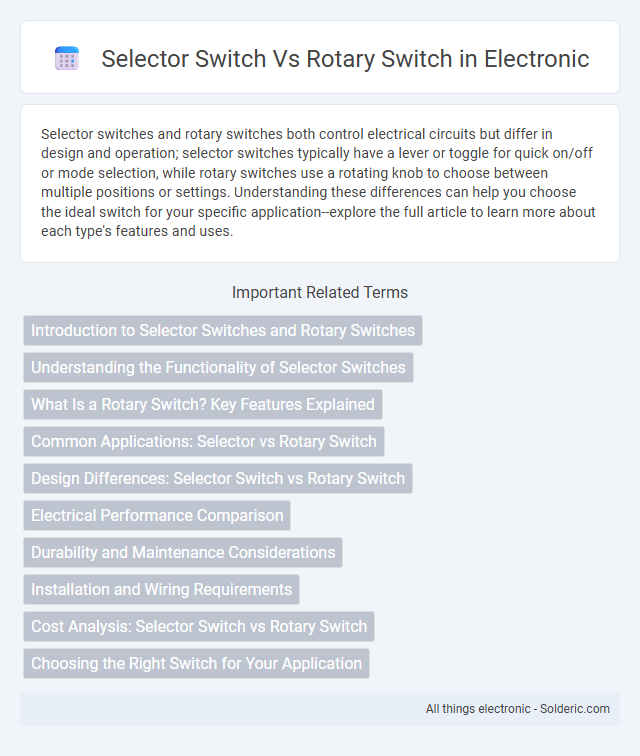Selector switches and rotary switches both control electrical circuits but differ in design and operation; selector switches typically have a lever or toggle for quick on/off or mode selection, while rotary switches use a rotating knob to choose between multiple positions or settings. Understanding these differences can help you choose the ideal switch for your specific application--explore the full article to learn more about each type's features and uses.
Comparison Table
| Feature | Selector Switch | Rotary Switch |
|---|---|---|
| Function | Simple on/off or mode selection | Multiple position selections with complex circuit routing |
| Operation | Linear or toggle movement | Rotational movement through fixed positions |
| Positions | Usually 2-3 positions | Multiple (commonly 2 up to 12 or more positions) |
| Application | Basic control panels, equipment start/stop | Complex switching in electronics, multi-circuit control |
| Durability | Good for frequent switching, simpler mechanism | Robust for multiple connections, mechanical complexity |
| Cost | Lower cost, simple design | Higher cost, complex design |
Introduction to Selector Switches and Rotary Switches
Selector switches and rotary switches serve distinct functions in controlling electrical circuits, with selector switches typically used for simple on/off or multi-position control in industrial environments. Rotary switches feature a rotating spindle that allows for multiple positions or circuit selections, ideal for complex control tasks requiring precise input options. Both switches optimize user interaction with machinery, enhancing operational flexibility and reliability in diverse applications.
Understanding the Functionality of Selector Switches
Selector switches enable you to choose between multiple circuit paths or settings by rotating a lever or knob to specific positions. Unlike rotary switches, which often allow continuous adjustment, selector switches provide discrete, fixed positions for precise control in industrial and electronic applications. Their functionality is critical for safely directing power flow, selecting operating modes, or configuring device settings accurately.
What Is a Rotary Switch? Key Features Explained
A rotary switch is an electromechanical device that allows the user to select one of multiple circuits by rotating a knob or shaft, commonly found in industrial controls and audio equipment. Key features include multiple positions, high current capacity, and durable contacts designed for frequent switching. Unlike selector switches with simple on/off or a few options, rotary switches provide precise control over numerous circuits in a compact design.
Common Applications: Selector vs Rotary Switch
Selector switches are commonly used in control panels and machinery for selecting different machine modes or circuit paths due to their simple on/off or multi-position design. Rotary switches excel in audio equipment, instrumentation, and telecommunications by allowing precise selection among multiple settings or channels. Your choice depends on the need for quick toggling (selector) versus multiple discrete positions with clear feedback (rotary).
Design Differences: Selector Switch vs Rotary Switch
Selector switches feature a simple linear or toggle design allowing users to choose between multiple fixed positions, often used for on/off or function selection. Rotary switches employ a circular, rotating mechanism enabling a wide range of circuit options with multiple detents for precise position control. The design difference directly impacts their application flexibility, with selector switches favoring straightforward, limited choices and rotary switches supporting complex multi-position configurations.
Electrical Performance Comparison
Selector switches offer reliable electrical performance with clear on/off states and are ideal for simple circuit control, providing consistent current handling and minimal contact resistance. Rotary switches deliver versatile electrical functionality by allowing multiple contact points within a single device, supporting complex circuit configurations with smooth transition between positions and typically higher durability under frequent switching. Your choice between these switches should consider load ratings, contact resistance, and switching frequency to ensure optimal performance for your specific electrical application.
Durability and Maintenance Considerations
Selector switches typically offer enhanced durability due to their simpler construction, making them less prone to mechanical wear and requiring minimal maintenance over time. Rotary switches, while versatile with multiple positions, often involve more complex internal components, which can lead to increased maintenance needs and potential failure points. Your choice should consider the operating environment and the frequency of switching to ensure optimal longevity and reduced upkeep.
Installation and Wiring Requirements
Selector switches typically feature straightforward installation with fewer wiring terminals, making them ideal for simple control circuits and quick setup. Rotary switches require more complex wiring due to multiple contact points and positions, demanding careful attention to terminal connections for accurate function. Your choice influences installation time and wiring complexity based on the application's electrical control needs.
Cost Analysis: Selector Switch vs Rotary Switch
Selector switches generally cost less than rotary switches due to simpler design and fewer moving parts, making them a budget-friendly option for basic control applications. Rotary switches, while more expensive, offer multiple contact positions and greater functionality, justifying the higher investment in complex systems requiring precise control. Cost analysis must consider both initial purchase price and long-term maintenance, where selector switches typically incur lower expenses.
Choosing the Right Switch for Your Application
Selector switches and rotary switches both control electrical circuits, but their design and function differ significantly, influencing your choice based on application needs. Selector switches typically offer simple, predefined positions for quick operation, making them ideal for basic on/off or mode selection tasks, while rotary switches provide multiple contact positions for more complex control, such as multi-speed motors or multi-circuit devices. Understanding the specific requirements of your application, including the number of positions, durability, and ease of use, ensures you select the right switch to optimize performance and reliability.
Selector switch vs Rotary switch Infographic

 solderic.com
solderic.com